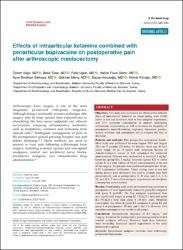| dc.contributor.author | Sağır, Özlem | |
| dc.contributor.author | Tatar, Betül | |
| dc.contributor.author | Ugün, Fatih | |
| dc.contributor.author | Demir, Hafize Fisun | |
| dc.contributor.author | Balkaya, Ayşe Neslihan | |
| dc.contributor.author | Meriç, Gökhan | |
| dc.contributor.author | Kocaoğlu, Nazan | |
| dc.contributor.author | Köroğlu, Ahmet | |
| dc.date.accessioned | 2021-04-21T10:19:22Z | |
| dc.date.available | 2021-04-21T10:19:22Z | |
| dc.date.issued | 2020 | en_US |
| dc.identifier.issn | 2687-4784 | |
| dc.identifier.issn | 2687-4792 | |
| dc.identifier.uri | https://doi.org/10.5606/ehc.2020.75274 | |
| dc.identifier.uri | https://hdl.handle.net/20.500.12462/11464 | |
| dc.description | Sağır, Özlem (Balikesir Author) | en_US |
| dc.description.abstract | Objectives: This study aims to evaluate the effect of two different doses of intraarticular ketamine on visual analog scale (VAS) scores at rest and movement, time to first analgesic requirement, and 24-h morphine consumption in patients undergoing arthroscopic meniscectomy as well as to assess the frequency of postoperative nausea&vomiting. respiratory depression. pruritus, urinary retention. and constipation and to compare the time to discharge.
Patients and methods: This prospective randomized double-blind study was performed between August 2013 and August 2014 on 75 patients (32 males. 43 females: mean age 46.7 +/- 13 years: range, 18 to 75 years) with American Society of Anesthesiologists scores of I-II scheduled for unilateral meniscectomy. Patients were randomized to receive 0.5 mg.kg(-1) ketamine (group K1). 1 mg.kg(-1) ketamine (group K2) or saline (group S) to a total volume of 20 mL intraarticularly at the end of the surgery. All patients were performed periarticular 10 mL 0.5% bupivacaine infiltration. Visual analog scale at rest and during passive knee movement was used to evaluate pain both preoperatively and at postoperative 0. 30 min. and 1. 2. 4, 6. 12, and 24 h. Time to first analgesic requirement and morphine consumption were recorded.
Results: Visual analog scale scores at rest and during movement at postoperative 0 were significantly reduced in group K2 compared with group S (p<0.05). The first analgesic requirement time was significantly longer in group K1 (76.9 +/- 25.2 min) and group K2 (93.4 +/- 26.1 min) than group S (29.3 +/- 7.1 min). Morphine consumption was lower in group K2 compared to group K1 and group S at postoperative 30 min. and 1 and 2 h. However. 24-h morphine consumption was similar in all groups.
Conclusion: Intraarticular injection of 0.5 mg.kg(-1) and 1 mg.kg(-1) ketamine for postoperative pain management provided similar analgesic efficacy. However, high dose ketamine more noticeably decreased opioid requirement in the early postoperative period. | en_US |
| dc.language.iso | eng | en_US |
| dc.publisher | Turkish Joint Diseases Foundation | en_US |
| dc.relation.isversionof | 10.5606/ehc.2020.75274 | en_US |
| dc.rights | info:eu-repo/semantics/openAccess | en_US |
| dc.subject | Intraarticular Analgesia | en_US |
| dc.subject | Ketamine | en_US |
| dc.subject | Knee Arthroscopy | en_US |
| dc.subject | Periarticular Bupivacaine | en_US |
| dc.title | Effects of intraarticular ketamine combined with periarticular bupivacaine on postoperative pain after arthroscopic meniscectomy | en_US |
| dc.type | article | en_US |
| dc.relation.journal | Joint Diseases and Related Surgery | en_US |
| dc.contributor.department | Tıp Fakültesi | en_US |
| dc.contributor.authorID | 0000-0001-7468-7288 | en_US |
| dc.identifier.volume | 31 | en_US |
| dc.identifier.issue | 2 | en_US |
| dc.identifier.startpage | 589 | en_US |
| dc.identifier.endpage | 596 | en_US |
| dc.relation.publicationcategory | Makale - Uluslararası Hakemli Dergi - Kurum Öğretim Elemanı | en_US |


















